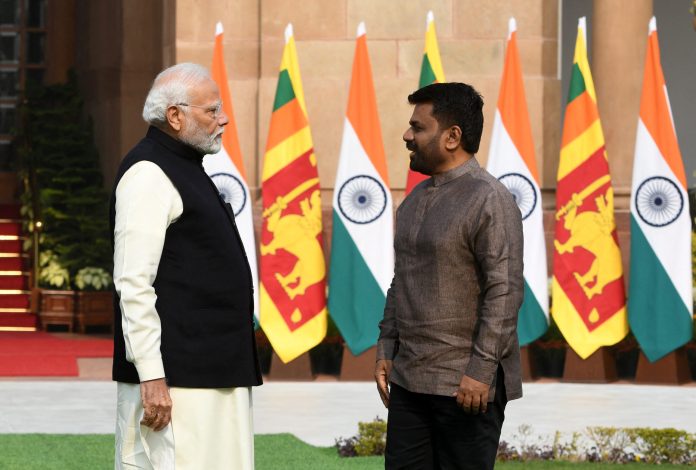By P.K.Balachandran
Colombo, April 3: Indian Prime Minister Narendra Modi will visit Sri Lanka from April 4 to 6 to bolster economic and strategic ties with New Delhi’s southern neighbor. The visit comes at a critical juncture as India navigates shifting dynamics in South Asia, including uncertainties surrounding Sri Lanka’s left-nationalist government under President Anura Kumara Dissanayake, the fallout from the ouster of the India-friendly Sheikh Hasina regime in Bangladesh, and growing Chinese influence in the region.
Recent developments have strained India’s regional relationships. Bangladesh’s tilt toward Pakistan and China, rumors of Indian backing for a Hindu nationalist movement to restore Nepal’s monarchy, and the Maldivian President Mohamed Muizzu’s renewed engagement with Beijing via a Free Trade Agreement have heightened New Delhi’s concerns. Against this backdrop, Modi’s visit aims to ensure India-Sri Lanka relations remain robust and resilient.
Economic Ties: A Strong Foundation with Room to Grow
India and Sri Lanka share a robust economic partnership. In 2023-24, bilateral trade reached US$5.54 billion, with India exporting US$4.11 billion and importing US$1.42 billion. From April to November 2024, two-way trade totaled US$3.67 billion. Yet, Sri Lanka has yet to fully leverage the India-Lanka Free Trade Agreement (FTA), operational since 2000. Modi’s visit seeks to deepen and diversify this economic collaboration.
India’s Foreign Direct Investment (FDI) in Sri Lanka stood at US$2.25 billion through 2023, with US$198.1 million invested that year alone and US$80.55 million from January to September 2024. Key sectors include energy, hospitality, real estate, manufacturing, telecom, and finance. Negotiations for an Economic and Technology Cooperation Agreement (ETCA), resumed in October 2023 after a five-year pause, are also on the agenda.
Several connectivity initiatives are in progress, including an Economic Land Corridor between Trincomalee and Colombo, a multi-product pipeline with UAE involvement, and a power grid interconnection. India has pledged US$61.5 million to develop Kankesanthurai port in Jaffna and is planning ferry services between Rameswaram and Thalaimannar. During the visit, Modi and Dissanayake will virtually launch a solar energy project in Sampur, underscoring energy cooperation as a cornerstone of the partnership. India’s US$4.5 billion aid package in 2022-23, which helped Sri Lanka weather an economic crisis, and its role in securing a Paris Club debt repayment plan further highlight this commitment.
Defense Cooperation: A Strategic Leap Forward
Modi’s visit could mark a historic expansion of defense ties if a proposed enhanced defense pact is signed. Indian Foreign Secretary Vikram Misri announced on March 28 in New Delhi that a new agreement is in the works, building on existing annual defense dialogues, naval exchanges, and joint exercises. “We very much hope that [it] can be concluded during this visit,” Misri said, noting that the draft incorporates Sri Lankan inputs.
The agreement aims to counter China’s growing presence in the Indian Ocean by deepening maritime surveillance, counter-terrorism collaboration, and potentially providing Sri Lanka with defense assets. Speculation in Sri Lanka suggests India may also push to sell indigenously made arms or establish manufacturing facilities on the island. India’s defense exports hit a record Rs. 23,622 crore (approximately US$2.76 billion) in FY 2024-25, with public and private sectors contributing significantly. In May 2024, Sri Lanka’s then-State Minister of Defense, Premitha Bandara Tennakoon, expressed interest in adopting India’s model of domestic arms production, though no immediate purchases were planned.
However, the proposed pact has sparked domestic opposition. Samagi Jana Balawegaya (SJB) leader Tissa Attanayake criticized the National People’s Power (NPP) government for lacking transparency, demanding public approval for agreements exceeding five years. Namal Rajapaksa of the Sri Lanka Podujana Peramuna (SLPP) sought clarity on the benefits to Sri Lanka, while the Sarva Jana Balawegaya warned of risks to national security, noting Sri Lanka’s lack of prior defense pacts with foreign nations. Misri countered that the agreement is an update to existing cooperation, not an entirely new framework.
Fisheries Dispute: A Persistent Thorn
The recurring issue of Tamil Nadu fishermen poaching in Sri Lankan waters will feature in the talks. In 2024, over 500 Indian fishermen were arrested—roughly two per day—with 97 still in Sri Lankan custody as of March, according to India’s External Affairs Minister. Tamil Nadu Chief Minister M.K. Stalin has pressed New Delhi to address the issue, recently passing a state assembly resolution to “retrieve” Katchativu island, ceded to Sri Lanka in the 1970s. Sri Lanka disputes Tamil Nadu’s claims, arguing that poachers encroach close to its shores. Misri emphasized a humanitarian approach, advocating dialogue between fishermen from both sides, though no shift in Katchativu’s status is expected given India’s binding bilateral agreement.
Adani Controversy: A Commercial Concern
Some Sri Lankans fear India might leverage the visit to pressure Colombo into resolving a tariff dispute involving the Adani Group’s 484 MW wind power project in Mannar. Given the close ties between Modi and the Adani family, speculation of informal discussions persists. However, as a commercial matter between a private Indian firm and the Sri Lankan government, it is unlikely to dominate formal talks.
Conclusion
To sum up, Modi’s visit underscores India’s determination to fortify its partnership with Sri Lanka amid a complex regional landscape. By enhancing economic collaboration, advancing defense ties, and addressing longstanding irritants, New Delhi aims to secure its southern flank and counterbalance China’s influence in the Indian Ocean.
END



 Logging you in...
Logging you in... Loading IntenseDebate Comments...
Loading IntenseDebate Comments...

